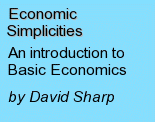




Introduction to
Economics
Lesson 19 / 07
XMAS
In most societies,
based on, or linked to, the Christian religion, Christmas, falling as it
does, in close proximity to the New Year, is the most significant annual
celebration in the calender. This
is despite [or perhaps because] of the fact that many of its origins are
secular or pagan rather than Christian.
Some of the aspects
associated with Christmas include feasting, decorating and erecting of
traditional symbols, exchanging of gifts and cards, attending churches
and religious celebrations, holidaying and the expressing of peace,
benevolence and good will towards people generally.
We can examine these aspects from an economics viewpoint.
Exchanging of
Gifts & Cards
The tradition of
exchanging gifts at Christmas time has waxed and waned over the ages.
The modern practice is said to have begun in early C19 North
America and to have received much of its impetus from the 1822 poem by C
C Moore “ A Visit from St
Nicholas” which begins “ Twas the Night before Xmas”.
The popular image
of the bearer of the gifts, being a roly-poly white-bearded old man
referred to by various names, including Santa Claus, Father Xmas or St
Nicholas, first appeared as a cartoon character drawn by a Harper’s
Weekly cartoonist, Thomas Nast, in 1863, which was adopted and
standardised over the next few decades, world-wide, by retailers and
advertisers.
Today Xmas has
evolved in many countries into the main shopping season, starting in
some instances as early as October and extending into January.
It is estimated that in the USA, 25% of retail sales occur
between Thanksgiving, [celebrated on the 4th Thursday in
November] and Christmas and that this period gives rise to 60% of
retailers’ profits.
The Shopping Season
in America is said to begin on Black Friday, [the day after
Thanksgiving]. when many stores run major promotions.
During the Great Depression President Roosevelt contemplated
moving Thanksgiving forward to extend the Shopping Season for the
proposed purpose of boosting the economy, but which gave rise to a storm
of protest about commercialising Xmas.
The practice of
exchanging Xmas gifts has led some economists to examine the practice
critically as being inherently inefficient and wasteful, giving rise to
what is referred to as a deadweight loss.
Thus it was calculated in 2001 that Xmas in the USA alone had
caused a deadweight loss of US$4 billion.
The supposed deadweight loss allegedly occurs because consumers
are said to maximise efficiency when they themselves purchase what they
themselves want, rather than when others purchase for them.
The amount of the
deadweight loss is calculated by determining the difference between what
the purchasers of the gifts paid for them, compared to what the
recipients of the gifts would have paid for them, if they were
purchasing such items for themselves.
Another, [typically
lesser,] deadweight loss figure can be calculated if one were to use
instead of the amount that the recipients would have paid for their
gifts, the amount they would require if they were to sell them.
Many economists however consider the whole concept of deadweight
loss as economic nonsense, since it does not take into account the
satisfaction that the purchaser of the gift receives from buying and
giving the gift or that the recipient receives from getting it.
Comparing what you buy for yourself to a gift you receive is to
compare apples with oranges. It can not be done; they are different
things.
The Xmas Message
One aspect of Xmas
that some economists have examined with a critical eye is the message of
Xmas, expressed through the stories, plays, poems and films that we use
to amuse and entertain us whilst we enjoy the occasion.
They purport to see in the more endearing examples of such works
a consistent misguided economic view of the world.
Dickens “A
Christmas Carol” is perhaps the most widely known Christmas story and
“Miracle on 34th Street” and “It’s a Wonderful
Life” perhaps the 2 most popular Christmas films. In all of these, it is said, profit and those who pursue it
are cast in a bad light, as being pursuits basically contrary to the
leading of a good and decent life.
The failure of such works seemingly to see anything worthwhile
whatsoever in the lives and work of the driven, miserable but
financially successful characters therein reflects and promotes, in the
view of such economists, a muddle-headed view of economics.
Feasting,
Holidaying and decorating
Such activities
reflect the non-spiritual and commercial aspects of Christmas, which
are, on occasion, deplored by those who prefer it as an occasion and an
opportunity for the expression of spiritual belief, benevolence and
compassion. There is a
continuing tension between such activities.
It appears however
that the ability of Christmas to accommodate both the commercial and
spiritual at the same time might explain its undoubted ongoing success
as arguably the World’s leading festival.
As a result, Christmas provides considerable scope and
opportunity for marketeers, much less so for economists.
David Sharp
27 November 2007